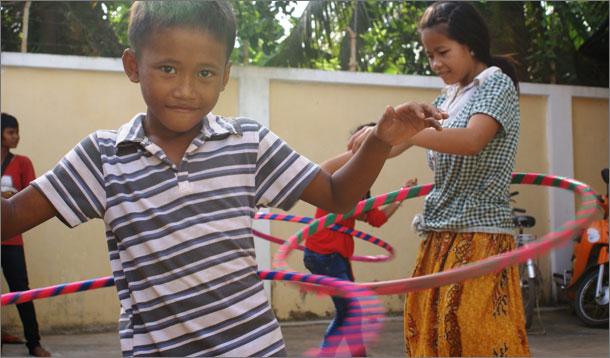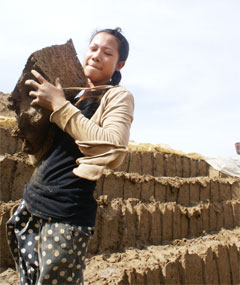
Last year I visited a Cambodian brick factory where children and teenagers worked long, hard days in the blazing sun. I can’t forget the eerie grinding noise that was so loud I had to cover my ears. I had heard of this machine. The week before, my World Vision colleagues told me it had chewed a girl’s arm off.

Machines like these are used to shape clay into bricks. Feeding it lumps of clay with her bare hands was a girl of 16, Vanna Chhua. Although factory workers in the area have now agreed to restrict this machine work to children over 12, Vanna had been doing this since she was 11. Her slender hands were so close to those grinding jaws. God forbid she should make an error in timing.
Feeding the machine was just part of Vanna’s job. She also had to cut huge lumps of clay-rich soil from the small quarry outside. She hauled them up onto her shoulder, and carried them inside. Once the bricks were shaped, Vanna pushed them to the oven in a huge cart. Vanna’s feet were bare next to the crushing wheels.
As we checked into our hotel that night, I stopped abruptly in the doorway, noticing that the building was made of brick. I felt a wave of nausea. Had a teenage girl risked her arm to make these bricks?
More than 115 million children are doing dirty, dangerous, and degrading work around the world. Work that is damaging their bodies, minds and well-being. Many have dropped out of school; many are not able to escape their situation. Sadly, they’re often making products destined for Canada.
For me, it was the Bangladesh factory collapse several weeks ago that brought it all home. When I saw photos of workers being pulled from the rubble, my mind went straight to my son’s closet. I couldn’t bear to think of him working in a place like that. Could his clothes have been sewn by one of those workers, perhaps a teenager trying to help her family make ends meet? The thought still haunts me.
Since then, my friends and family have been asking what Canadians can do to help. How are moms like us supposed to know where the things we buy actually come from and who made them? Things like chocolate, flowers, clothing, toys, seafood and electronics. Tracking ethical problems in supply chains is complex, but here are a few ways to figure things out:
It might feel like a far-away problem, yet growing numbers of Canadians are realizing our connections and responsibility. In a recent poll, 89 per cent said they would pay more for child labour-free products, up from 68 per cent last year. Canadians also said they would pay on average 23 per cent more to guarantee a purchase is child labour-free (double the amount they said a year ago).
One thing is certain: we can’t point fingers, we need to join hands. Fixing the tragedy of child slavery will take governments, companies, and consumers all working together.
To learn more visit: nochildforsale.ca
Caroline Riseboro with children in Cambodia 2012. The Cambodian children Caroline visited were vulnerable to child slavery. Many were forced to work in factories to help keep their families alive.
![]() Hear Erica's plea to put a stop to child slavery.
Hear Erica's plea to put a stop to child slavery.
![]() Find out what World Vision is doing to stop child marriage.
Find out what World Vision is doing to stop child marriage.
![]() Learn how to buy ethical chocolate.
Learn how to buy ethical chocolate.
![]() Read how Erica is teaching her children about human rights.
Read how Erica is teaching her children about human rights.
![]() Check out Erica's post about how dirty a child's work can actually get.
Check out Erica's post about how dirty a child's work can actually get.
![]() Learn about the sad state of children and human trafficking from Carleen McGuinty.
Learn about the sad state of children and human trafficking from Carleen McGuinty.
Visit World Vision’s End Child Slavery campaign at endchildslavery.ca.

